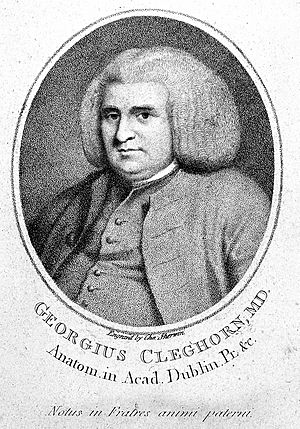George Cleghorn (Scottish physician) facts for kids
George Cleghorn (1716–1789) was a Scottish doctor, also known as a physician. He was very good at carefully observing and understanding different types of fevers. He helped explain how malaria could make these fevers more complicated or harder to understand.
Contents
Early Life and Education
George Cleghorn was born on December 18, 1716, near Granton, in northern Edinburgh, Scotland. He was the youngest of five children in his family. He started his schooling at the grammar school in Cramond.
In 1731, George began studying medicine at the University of Edinburgh. He lived in the home of his teacher, Alexander Monro, who was a famous anatomy professor. During this time, he met another future doctor, John Fothergill. They became close friends and wrote letters to each other for the rest of their lives.
Working as a Surgeon
In 1736, George Cleghorn became a surgeon for the 22nd Regiment of Foot, a British army group. This regiment was stationed on the island of Menorca (also called "Minorca" by the British). He stayed on Menorca for many years, until the regiment was moved to Dublin, Ireland, in 1749.
While in London in 1750, Cleghorn attended special lessons on anatomy given by William Hunter. Anatomy is the study of the body's structure.
Teaching in Dublin
George Cleghorn moved to Dublin in 1751. There, he started teaching anatomy to students. A few years later, he became the first lecturer in anatomy at Trinity College, Dublin. He then became a professor there.
His lessons covered different areas of anatomy, including how the bodies of various animals are structured (comparative anatomy) and how the body works (physiology). He was a very successful doctor in his own practice.
In his later years, Cleghorn spent a lot of time on a small farm he owned near Dublin. He was also one of the first members of the Royal Irish Academy, a group that promotes learning and science. He passed away in December 1789.
Important Medical Work
Cleghorn's most important book was called Observations on the Epidemical Diseases in Minorca from the year 1744 to 1749. He published it in 1751. He had been writing to his friend John Fothergill about his medical observations in Menorca. Fothergill encouraged him to turn his letters into a book.
The book had seven chapters. It contained new observations about the diseases that affected both the local people and the British soldiers on the island. Cleghorn had performed many post-mortem examinations, which means he carefully examined bodies after death to understand diseases.
Cleghorn explained that some confusing statements from ancient Greek medical writings (like those by Hippocrates) made more sense when you looked at diseases in Mediterranean areas. He showed that many illnesses, both short-term and long-term, were often changed or made worse by malarial fever.
Even though doctors at the time didn't fully understand diseases like enteric fever (a type of typhoid) or acute pneumonia, Cleghorn's book gave a very good description of how enteric fever could be complicated by tertian ague (a type of malaria) or dysentery. His careful observations at the patient's bedside were very valuable. His book was so important that it was published four times during his lifetime, and a fifth time in 1815.
Family Life
George Cleghorn did not have any children of his own. However, he raised the nine children of his deceased brother. One of these children, William Cleghorn, also became a doctor. He earned his medical degree in Edinburgh in 1779 and wrote a paper on the theory of fire. Sadly, he died just a few years after graduating.


